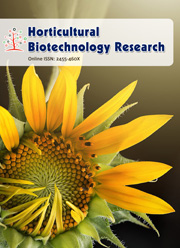Control of contaminants during introduction and establishment of Bambusa vulgaris in vitro
DOI:
https://doi.org/10.19071/rib.2016.v7.3056Abstract
The aim of this work was to test techniques to reduce microbial contamination in the phases of introduction and establishment of the in vitro cultivation of Bambusa vulgaris through two experiments. The first experiment was carried out in a completely randomized design using a factorial arrangement (pre-treatment of nodal segments using or not a solution of Derosal 500 SC® and Chloramphenicol × culture medium with half or full concentration of salts × culture medium with presence or absence of sucrose × culture medium with presence or absence of Plant Preservative MixtureTM). In a second experiment, carried out in a completely randomized design, the effect of different fungicides associated to Chloramphenicol in a liquid culture medium was tested. It was possible to verify that the isolated effects of the pre-treatment by immersion of the nodal segments in a solution of 4 mL L-1 of Derosal 500 SC® and 200 mg L-1 of Chloramphenicol for 30 minutes and explants placed in a sucrose-free medium reduced fungal contamination. In the second experiment, the treatment that reduced fungal contamination corresponded to explants placed for seven days in a liquid medium with half the concentration of salts, sucrose-free, with 2 mL L-1 of Plant Preservative MixtureTM and with 4 mL L-1 of  Derosal 500 SC® and 200 mg L-1 of Chloramphenicol.Downloads
References
ALI AH, NIRMALA, C, BADAL T, SHARMA ML. In vitro Organogenesis and Simultaneous Formations of Shoots and Roots from Callus in Dendrocalamus asper. Horticulture 2009; 6: 31-40
ANAND M, BRAR J, SOOD A. In Vitro Propagation of Edible Bambu Bambusa bambos and Assessment of Clonal Fidelity through Molecular Markers. Journal of Medical and Bioengineering 2013; 2(4): 257-261
ARYA ID, ARYA S. Propagation of Bamboos through Culture Technology and Field Plantation. Horticulture 2009; 6: 131-143
GENEROSO, AL. Caracterização Morfológica e Cultivo in vitro de Espécies de Bambu. Dissertação (Mestrado em Genética e Melhoramento de Plantas) – Centro de Ciências e Tecnologias Agropecuárias, Universidade Estadual Norte Fluminense Darcy Ribeiro, Campos dos Goytacazes-RJ; 2014.
JHA A, DAS S, KUMAR B. Micropropagation of Dendrocalamus hamiltonii through nodal explants. Global Journal of Bio-Science and Biotechonolgy 2013; 2(4): 580-582
JIMÉNEZ, VM, CASTILLO J, TAVARES E, GUEVARA E, MONTIEL M. In vitro propagation of the neotropical giant bamboo. Guadua angustifolia Kunt, trough axillary shoot. Plant Cell Tissue Organ Culture 2006; 86: 389-395
LIN, X.; HUANG, L.; FANG, W. Bamboo regeneration via embryogenesis and organogenesis. In: Sato, Ken-Ichi, editor. Embryogenesis. Rijeka: INTECH; 2012. p. 359-372.
MANHÃES AP. Caracterização da Cadeia Produtiva do Bambu no Brasil: Abordagem Preliminar. Monografia (Bacharelado em Engenharia Florestal) – Departamento de Silvicultura, Instituto de Florestas, Universidade Federal do Rio de Janeiro, Seropédica-RJ; 2008.
MSOGOYA T, KANIAGHA H, MUTIGITU J, KULEBELWA M, MAMIRO D. Identification and Management of Microbial Contaminants of Banana in vitro Cultures. Journal of Applied Biosciences 2012; 55: 3987-3994
MUDOI KD, SAIKIA SP, BORTHARKHUR M. Effect of nodal positions, seasonal variations, shoot clump and growth regulators on micropropagation of commercially important bamboo, Bambusa nutans Wall. Ex. Muro. African Journal of Biotechnology 2014; 19(19): 1961-1972
MURASHIGE T, SKOOG, F. A revised médium for rapid growth and bioassays with tobacco tissue culture. Physiology Plant 1962; 15: 473-497
PANDEY BN, SINGH, NB. Micropropagation of Dendrocalamus strictus Nees from mature nodal explants. Journal of Applied Natural Science 2012; 4(1): 5-9
PFALTZGRAFF PAS. Sistema de informações geoambientais da Região Metropolitana do Recife. Recife: CPRM-Serviço Geológico do Brasil; 2003.
SAYANIKA D, SHARMA GJ. In vitro propagation of Arundinaria callosa Munro- an edible bamboo from nodal explants of mature plants. The Open Plant Science Journal 2009; 3: 35-39
SAXENA S. BHOJWANI SS. In vitro clonal multiplication of 4-year-old plants of bamboo, Dendrocalamus longispathus Kurz. In vitro Cell. Dev. Biol. Plant. 1993; 29: 135-142
SHARMA P, SARMA KP. In vitro propagation of Bambusa balcooa for a better environment. In: International Conference on Advances in Biotechnology and Pharmaceutical Sciences. Bangkok: Planetary Scientific Research Centre; 2011 p. 248-252
SHARMA S, SARMA KP. In Vitro Propagation of Bambusa tulda: An Important Plant for Better Environment. Journal of Enviromental Research and Development 2013; 7(3): 1216-1223
RAMANAYAKE, SMSD, MEEMADUMA VN, WERAWARDENE TE. In vitro shoot proliferation and enhacement of rooting for the large scale propagation of yellow bamboo (Bambusa vulgaris ‘Striata’). Sci. Hort. 2006; 110: 109-113
RAMANAYAKE, SMSD, YAKANDAWALA K. Micropropagation of the giant bamboo (Dendrocalamus giganteus Munro) from nodal explants of field grown culms. Plant Sci. 1997; 129: 213-223
WADAKTAR CM, MORE NV, PATIL VV. Initiation of suspension culture and somatic embryogenesis to plant regeneration in multipurpose bamboo (Dendrocalamus tulda). Indian Journal of Applied Research 2014; 4(1): 149-151



 .
.